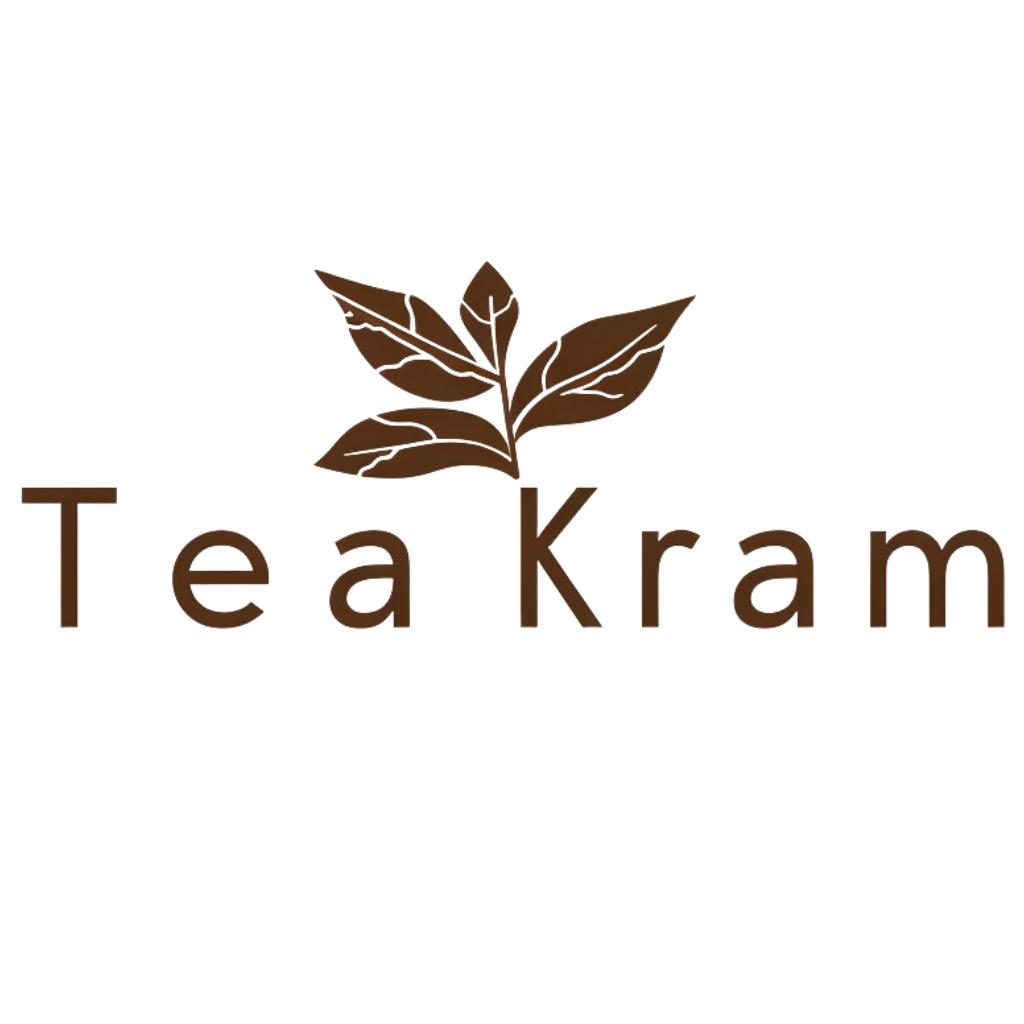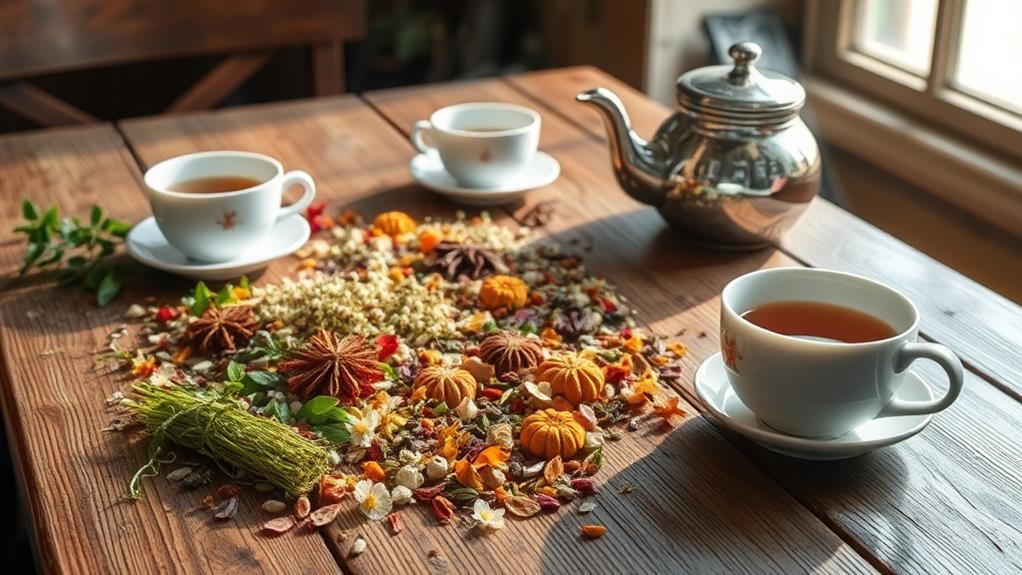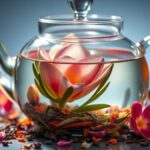When you sip your tea, you might not realize how many local ingredients can enhance its flavor and health benefits. Herbs like lavender bring calm, while echinacea may help fight off colds. Foraged wildflowers, such as chamomile, add unique sweetness, and seasonal fruits, like strawberries and peaches, introduce vibrant freshness. Local spices, like mint and ginger, not only spice up your brew but also aid digestion. Even a drizzle of local honey brings a touch of nature's sweetness! Exploring these unsuspecting ingredients can turn your tea into a flavorful adventure filled with health benefits. There's so much more to discover!
Local Herbs and Their Benefits
Local herbs play an essential role in enhancing the flavor and health benefits of teas. You mightn't realize it, but incorporating these vibrant ingredients can elevate your tea experience to new heights. Imagine sipping a cup of chamomile tea, enriched with a few sprigs of fresh mint. The result? A revitalizing taste that soothes the senses!
Additionally, these local herbs are often rich in antioxidant and immune-boosting properties, further enhancing the health benefits of your brew.
But it's not just about flavor; local herbs boast impressive health benefits too. For instance, you may enjoy the calming effects of lavender, known for its ability to reduce stress and promote relaxation. If you're looking to boost your immunity, consider adding echinacea to your brew. This herb has been celebrated for its potential to ward off colds and flu.
Experimenting with local herbs opens up a world of possibilities. You can try mixing different herbs, discovering unique blends that suit your palate.
Plus, using locally sourced ingredients supports your community and reduces your carbon footprint. So, grab some fresh herbs from your garden or farmer's market, and let your creativity flow! With each cup, you'll not only delight your taste buds but also nourish your body in delightful ways.
Wildflowers for Flavor Enhancement
Wildflowers can transform your tea experience with their unique flavors and aromas. Imagine sipping a cup infused with the delicate sweetness of chamomile or the vibrant notes of hibiscus. These wildflowers not only add a splash of color but also enhance the taste profile of your favorite brews, much like how pairing tea with meals can elevate flavors and create a unique experience.
By incorporating wildflowers, you're inviting nature's artistry into your cup. Each flower brings its own character; for instance, lavender offers a soothing, aromatic touch, while rose petals can add a hint of romance. You've got endless possibilities here!
Experimentation is key; mixing different wildflowers can yield surprising and delightful results. Try blending dandelion flowers with green tea for a revitalizing twist or adding cornflowers to black tea for a pop of color and flavor.
Don't be afraid to get creative! You can even forage for these ingredients in your own backyard or local parks, making your tea both innovative and personal. Just remember to verify they're safe for consumption.
Foraged Ingredients in Tea Blends
Foraging adds a unique layer to your tea blends, allowing you to connect with nature while crafting personalized flavors. Imagine stepping outside, gathering ingredients that speak to the season, and infusing them into your brews. This hands-on experience makes your tea truly special!
Incorporating foraged ingredients can also enhance the health benefits of your brews, as many wild plants, like nettles and dandelions, are rich in vitamins and antioxidants, contributing to overall wellness and nutritional profile.
Here are three foraged ingredients you might consider:
- Nettle Leaves: Packed with vitamins and minerals, nettles add a rich, earthy flavor. Plus, they're known for their health benefits!
- Elderflower: With its delicate, floral notes, elderflower infuses your tea with a sweet aroma reminiscent of summer. It's like a warm hug in a cup!
- Dandelion Roots: Often overlooked, dandelion roots can add a slightly bitter yet intriguing flavor. They're also packed with antioxidants, making your tea a powerhouse of health.
Seasonal Fruits and Their Impact
Incorporating seasonal fruits into your tea blends can elevate your brews with fresh, vibrant flavors. Whether it's the crispness of autumn apples or the sweetness of summer strawberries, these fruits can add a delightful twist to your favorite teas. You'll not only enjoy a burst of flavor but also celebrate nature's bounty throughout the year.
Here's a quick look at some seasonal fruits and their potential impact on your tea:
| Season | Fruit | Flavor Profile |
|---|---|---|
| Spring | Strawberries | Sweet, slightly tart |
| Summer | Peaches | Juicy, fragrant, sweet |
| Autumn | Apples | Crisp, sweet, subtly spicy |
| Winter | Citrus (Oranges, Lemons) | Bright, zesty, invigorating |
When you choose fruits that are in season, you're ensuring the best taste and freshness. Plus, you support local farmers and reduce your carbon footprint. So, the next time you brew a cup, think about what fruits are in season. You might just discover a new favorite combination that'll make your tea experience even more exciting!
Spices From Nearby Gardens
When you think about making tea, don't forget the amazing spices that can come right from your own garden!
Fresh garden harvests not only add unique flavor profiles but also bring a host of health benefits that you'll want to explore. For instance, certain spices can act as a natural source of antioxidants, promoting overall health and protecting against free radicals a natural source of antioxidants.
Additionally, these ingredients can enhance digestion and even support your immune system, making your tea not just delicious but also beneficial for your well-being.
Let's uncover how these simple ingredients can elevate your tea experience in delightful ways!
Fresh Garden Harvests
Fresh garden harvests offer a treasure trove of spices that can elevate your tea experience.
Imagine brewing a cup of tea infused with the vibrant flavors of freshly picked herbs. It's not just about taste; it's about connecting to your local environment and enhancing your overall well-being with the health benefits of tea.
You can easily add a splash of innovation to your daily routine. Here are three garden spices to reflect upon:
- Mint: Crisp and invigorating, mint adds a cooling sensation that wakes up your senses.
- Basil: This versatile herb can bring a sweet, aromatic twist to your tea. Who knew basil could be so delightful?
- Thyme: With its earthy notes, thyme offers a unique depth, making every sip feel like a cozy hug.
These local spices can transform your tea into a sensory adventure.
Plus, they're often packed with health benefits, enhancing not just flavor but also well-being.
So, next time you step into your garden, think about the spices waiting to be harvested.
Experimenting with fresh ingredients can lead to delightful discoveries, encouraging you to sip sustainably while enjoying the local bounty.
Immerse yourself and let your taste buds explore!
Unique Flavor Profiles
Exploring unique flavor profiles from nearby gardens can truly elevate your tea experience. Imagine sipping a warm cup of tea infused with fresh herbs and spices you've just picked. You can create flavors that surprise and delight your taste buds!
Start with vibrant basil or mint, both of which grow easily in gardens. A few leaves can add a revitalizing twist to your traditional brew.
Next, consider adding a dash of cinnamon or ginger. These spices not only pack a punch but also harmonize beautifully with teas like chai or black tea.
You might also discover the rich, earthy notes of rosemary or the floral hints of lavender. These herbs bring complexity to your blend, transforming your average cup into a garden-inspired masterpiece.
Experimenting with these local ingredients is a fantastic way to release your creativity. You can try mixing different combinations to find what you love best.
Plus, sharing your unique blends with friends can spark conversations and inspire them to explore their own gardens.
Health Benefits Explored
Incorporating local spices into your tea not only enhances flavor but also packs a powerful punch of health benefits.
You might be surprised by how these everyday ingredients can transform your cup and boost your wellness. Check out these three incredible advantages:
1. Antioxidant Power: Many local spices, like cinnamon and ginger, are rich in antioxidants that help fight free radicals.
This means they can support your body in staying healthy and vibrant!
2. Digestive Aid: Sipping tea infused with spices like peppermint or fennel can soothe your stomach and promote better digestion.
It's like giving your gut a warm hug!
3. Mood Booster: Certain spices, such as turmeric and cardamom, can elevate your mood and reduce stress.
Imagine sipping a cup of tea that not only warms you up but also lifts your spirits!
The Role of Local Honey
Local honey plays an essential role in enhancing the flavor and health benefits of teas. When you stir in a spoonful of this golden goodness, you're not just sweetening your brew; you're also adding a unique flair that varies by region. Each local honey has its own distinct taste, influenced by the flowers nearby. This means your tea can take on exciting new dimensions with each different jar of honey you try!
Here's a quick look at how local honey can elevate your tea experience:
| Type of Honey | Flavor Profile | Best Tea Pairing |
|---|---|---|
| Wildflower Honey | Floral, light | Green Tea |
| Clover Honey | Sweet, mild | Herbal Tea |
| Orange Blossom Honey | Citrusy, vibrant | Black Tea |
Using local honey not only supports nearby beekeepers but also brings a natural sweetness that's hard to beat. So, next time you're brewing your favorite tea, consider reaching for a jar of local honey to add that special touch. You'll be amazed at how it transforms your cup!
Nutritional Boost From Local Plants
Adding local plants to your tea can really amp up its nutritional value. Imagine sipping on a warm cup that not only delights your taste buds but also gives your body a health boost!
Here are three incredible benefits you can enjoy:
- Vitamins and Minerals: Local plants often pack a punch of essential nutrients. For instance, adding dandelion leaves can provide vitamin A and C, while nettles are rich in iron.
- Antioxidants: Many local herbs, like rosemary and oregano, are loaded with antioxidants. These powerful compounds help fight off free radicals in your body, keeping you healthier and more vibrant.
- Digestive Support: Ingredients like mint or ginger can aid digestion and soothe your stomach. A cup of tea infused with these plants can be a great way to feel good from the inside out.
Using local plants in your tea isn't just innovative; it's a simple way to nourish your body while celebrating your surroundings.
Cultural Significance of Regional Ingredients
When you sip a cup of tea made from local ingredients, you're not just enjoying a tasty drink; you're also connecting with rich traditions.
Many regional plants have historical uses that tell stories about the people and cultures that embraced them.
Plus, these ingredients often carry deep symbolism, reflecting beliefs and values that have been passed down through generations.
Historical Uses in Teas
Tea has long been a canvas for cultural expression, with regional ingredients weaving rich stories into every cup.
Each sip takes you on a journey through time and tradition, revealing how local flavors shaped societies. Here are three historical uses of regional ingredients in teas that might surprise you:
- Medicinal Properties: Many cultures have turned to teas infused with local herbs for healing. For instance, ginger tea has been cherished in Asian cultures for its digestive benefits.
- Ceremonial Significance: In some communities, specific teas are brewed for rituals or celebrations. Imagine the vibrant gatherings where hibiscus tea is served, symbolizing unity and joy.
- Social Connection: Historically, sharing tea with neighbors or family members has fostered connections. Think about how a simple cup of chamomile could spark conversations that last for hours.
Symbolism in Local Cultures
Local ingredients in teas often carry deep cultural symbolism that reflects the values and beliefs of a community. When you sip a cup of tea brewed with local herbs or spices, you're not just enjoying a drink—you're experiencing a story.
For instance, in some cultures, chamomile symbolizes peace and tranquility, making it a go-to for relaxation after a long day. Meanwhile, hibiscus, with its vibrant color, is often linked to joy and celebration, marking special occasions.
In many regions, these ingredients serve as a connection to history and tradition. When you choose a tea infused with local fruits or flowers, you're honoring the land and the people who cultivate it, creating a bond that goes beyond mere consumption.
This is where innovation meets tradition; by experimenting with these local elements, you can craft unique flavors that tell a new story while respecting the old.
So, next time you brew your tea, think about the local ingredients you've chosen. They're more than just flavors—they're symbols of community, connection, and culture.
Embrace these insights and let your tea experience become a delightful journey into the heart of your surroundings!
Tips for Sourcing Local Additions
Finding the best local additions for your teas can elevate your brewing experience greatly. When you incorporate unique local ingredients, you're not just brewing a cup; you're telling a story.
Here are some tips to help you source those delightful additions:
- Visit Farmers' Markets: These vibrant spots are treasure troves of fresh herbs, fruits, and flowers. You'll meet passionate growers who can share their knowledge and recommendations.
- Connect with Local Foragers: Explore the world of wild ingredients! Foraging enthusiasts can guide you to edible plants that add a whole new layer of flavor to your teas. Just remember to verify they're safe to consume!
- Join Community Groups: Look for local tea enthusiasts or herbalist clubs. They often have great tips on sourcing ingredients and might even host events where you can sample new blends.
FAQ
What Are Some Common Allergens in Local Tea Ingredients?
When exploring local tea ingredients, you should be aware of common allergens like nuts, soy, and dairy. Always check labels, and ask about specific ingredients to guarantee your tea experience is safe and enjoyable.
How Can I Ensure My Foraged Ingredients Are Safe to Use?
To guarantee your foraged ingredients are safe, research each plant's identification, consult local experts, and use trusted guides. Always start with small amounts to test for reactions, and avoid areas with potential contaminants.
Are There Any Local Tea Blends That Are Caffeine-Free?
Sure, you'll find plenty of innovative, local tea blends that are caffeine-free. Think invigorating herbal infusions versus traditional black teas; they offer unique flavors while keeping you energized without the jitters. Explore your local blends today!
How Do Local Climates Affect Ingredient Availability?
Local climates shape what you can grow, influencing ingredient availability. Warmer areas might offer tropical herbs, while cooler regions excel in hardy plants. Embracing these variations fuels your creativity and sparks innovative tea blends unique to your locale.
Can I Substitute Dried Herbs for Fresh Ones in My Teas?
Imagine vibrant gardens bursting with fresh herbs, their essence alive. You can substitute dried herbs for fresh ones in your teas, but remember, dried herbs pack a stronger punch, so adjust quantities accordingly for balanced flavor.
Final Thoughts
So, next time you're brewing a cup of tea, remember that the best ingredients might be right outside your door. Who knew that your backyard could hold the secrets to a delicious, health-boosting brew? By using local herbs, wildflowers, and honey, you're not just making tea; you're creating a mini celebration of your community. It's funny how the most unsuspecting ingredients can turn an ordinary drink into a local masterpiece. Cheers to that!



